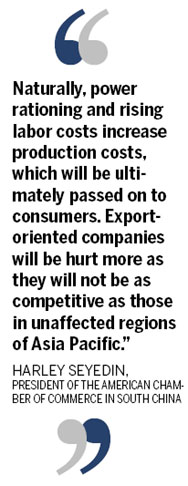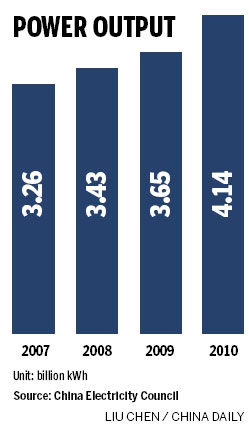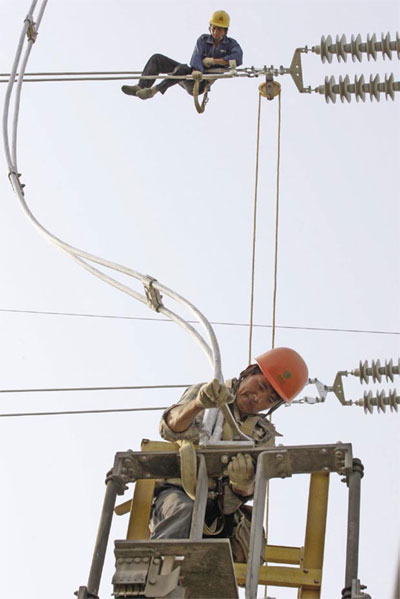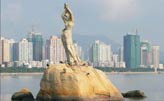China's power crunch may add to US price rises
Updated: 2011-06-10 10:58
By Meng Jing, Zhong Nan and Zhang Yuwei (China Daily)
|
|||||||||
|
Workers check power wires in Huaibei, East China's Anhui province, last month. Provided to China Daily |
BEIJING - With a great economy, comes great power. When China, then the world's seventh-largest economy, had its worst blackouts seven years ago, other countries could hardly feel anything except a pinch of short-term undersupply caused by suspended production.
But this time, the second-largest economy has a robust development and closer trade ties with all the major players in the world. Now when China suffers - this year's blackout are supposed to be worse than 2004 - the rest of the world will feel its pain, especially its largest exporting destinations, the United States and the European Union.
Low-priced "made in China" products filled the shelves in the US for the past decade. However, the surging labor costs coupled with the appreciation of the yuan has been challenging China's status as the world's factory.
With the arrival of the last straw, the severe power shortage, which has led to a rise in electricity prices and is likely to push up prices of other commodities, it seems impossible for the world's second-largest economy to remain a cheap goods exporter.
Instead, inflation may be added to the list of the country's latest exports, arriving at American ports with even higher-priced Chinese products.
More than 10 provinces in China have been hit badly by the power shortages. Suffering regions include cities in West China, Central China and export hubs in coastal China.
Power cuts and blackouts in the Pearl River Delta and the Yangtze River Delta started in March, several months earlier than usual. The most difficult time is yet to come, when more and more energy-hungry air conditioners kick in with the rising temperature.

The State Grid, China's main electricity distribution company, warned last month that the electricity shortfall this summer may be as high as 40 gigawatts (gW), surpassing the 2004 record.
In Cixi city, East China's Zhejiang province, blackouts started in mid-March this year, compared to September of last year.
Power rationing happens two days every five days, usually lasting 12 hours, in the chemical fiber production hub in coastal China.
Manufactures are using diesel generators to fill the gaps between low power supply and surging power demand.
However, using diesel generators comes at a price. The price of power generated by diesel is nearly 2 yuan (3 cents) for each kilowatt-hour (kWh), which is twice as much as power from electric grid, said Xu Shuhui, deputy general manager of Cixi Henghui Chemical Fiber Co.
"We can barely make ends meet when the power price reaches 1.5 yuan per kWh, let alone 2 yuan," Xu said, suggesting the company might have to increase the prices of its products.
Xu's company produces fabrics that are raw materials for textiles and clothes.
The United States is the second-largest importer of made-in-China clothes, spending $4.83 billion in the first quarter of 2011, according to Chinese Customs data.
American consumers will eventually pay for the rising production cost in China, partly thanks to the power crunch.
"Naturally, power rationing and rising labor costs increase production costs, which will be ultimately passed on to consumers," said Harley Seyedin, president of the American Chamber of Commerce in South China. "Export-oriented companies will be hurt more as they will not be as competitive as those in unaffected regions of Asia Pacific."
To ease the pressure of the power crisis, the Chinese government raised the electricity prices for industrial, agricultural and commercial users in 15 provinces in June, encouraging coal-fired companies to generate more power.
China's coal prices are mostly market-based, but the power prices are tightly controlled by the government. The main reason for China's power crunch this year is that the utility companies don't have the will to generate power, said Lin Boqiang, director of China Center for Energy Economics Research at Xiamen University.
"The high price of coal and the low price of power have stopped many coal-fired plants from operating. The more power they produce, the greater loss they endure," Lin said.
How effective the government's move can be is still unclear, but analysts have already pointed to the side effects brought by the rise of electricity prices.
The average 16.7 yuan per megawatt-hour boost for non-residential users will affect the consumer price index "indirectly" by 0.05 percentage point, China Central Television cited Liu Shujie, head of economic research at the National Development and Reform Commission, as saying on May 30. The commission is China's top economic planning agency.
Inflation was 5.3 percent in April, above the government's 2011 target of 4 percent.
The government may increase industrial power rates further and raise residential tariffs in the second half of 2011, said Shen Minggao, Citigroup's China research head.
A 10 percent consumer power price rise would push inflation up by 0.25 of a percentage point, he said.
The domestic inflation caused by a power shortage will add to other cost pressures in China.

"And it could feed into export prices for Chinese goods, which will in turn impact inflation in Europe and the US," said Duncan Freeman, senior research fellow with Brussels Institute of Contemporary China Studies at Vrije Universiteit Brussel.
Export prices of Chinese products had already been boosted in 2010 because of higher material and component expenses, according to a report from Global Sources, a Hong Kong-based business-to-business media company that facilitates trade between China and other regions.
In its latest survey of 232 exporters in February, 74 percent respondents said they increased export prices in 2010. The report points out that export prices are likely to increase in the months ahead, especially if the cost of major materials and components continues to rise.
A January survey from Global Sources shows that more than 50 percent of buyers intend to increase sourcing from India and Vietnam because Chinese exporters are becoming less competitive with other low-cost countries.
Unfortunately, inflation does not only flow to the US through imports, but also through rising prices of commodities and energy.
Societe Generale, a European financial services company, said in May that "the dynamic of China export inflation seems as inevitable as gravity itself" in its report The China Domino has Fallen!
"Chinese demand for oil and steel has pushed prices up in those markets. Now it is affecting commodities such as cotton and food products. That's being passed on to developed markets, like the US," the report said.
The surging demand is not only about oil and steel. China's appetite for energy resources, which aims to cure the ongoing power shortage, will likely push up prices of energy resources abroad.
China has shocked Asian energy markets by suspending diesel exports to ensure domestic supplies are adequate as demand for the fuel rises.
The decision in mid-May means a significant tightening of diesel supplies across Asia as China is a big exporter to Singapore and Vietnam.
The move was followed by the National Development and Reform Commission's announcement on June 1 that it encourages higher coal imports to ensure domestic supplies in the summer, peak power-consuming season.
Around 75 percent of power is generated by coal-fired plants in China. The country became a net importer of coal in 2007 and emerged as the world's second-largest coal importer after Japan in 2010, despite the fact that it is a major coal producer in the world.
The price of thermal coal at Qinhuangdao Port, a Chinese benchmark, reached 810 yuan a ton in May, 30 yuan higher than the previous month, according to China National Coal Association.
According to osc.org.cn, a major coal trading information and service website, thermal coal prices in the main harbors around the Bohai Sea have been increasing for 10 weeks since March.
International coal prices are also rising. Imported coal prices surged 22 percent year-on-year to $113.7 per ton in the first quarter of 2011, according to the Xinhua News Agency.
However, some argue that the risk of exporting inflation to the US can be reversed if the country starts to source from other countries, where production costs are lower.
"The power shortage will affect the prices of Chinese exports. In the short term, Chinese goods sold in the US and European markets will have pressure to increase prices," said James Leckie, professor of Environmental Engineering and Applied Earth Science at Standford University in California.
"But in the long run, due to the efficiency of a global economy, more goods will be produced outside China with reasonable prices."
China Daily












